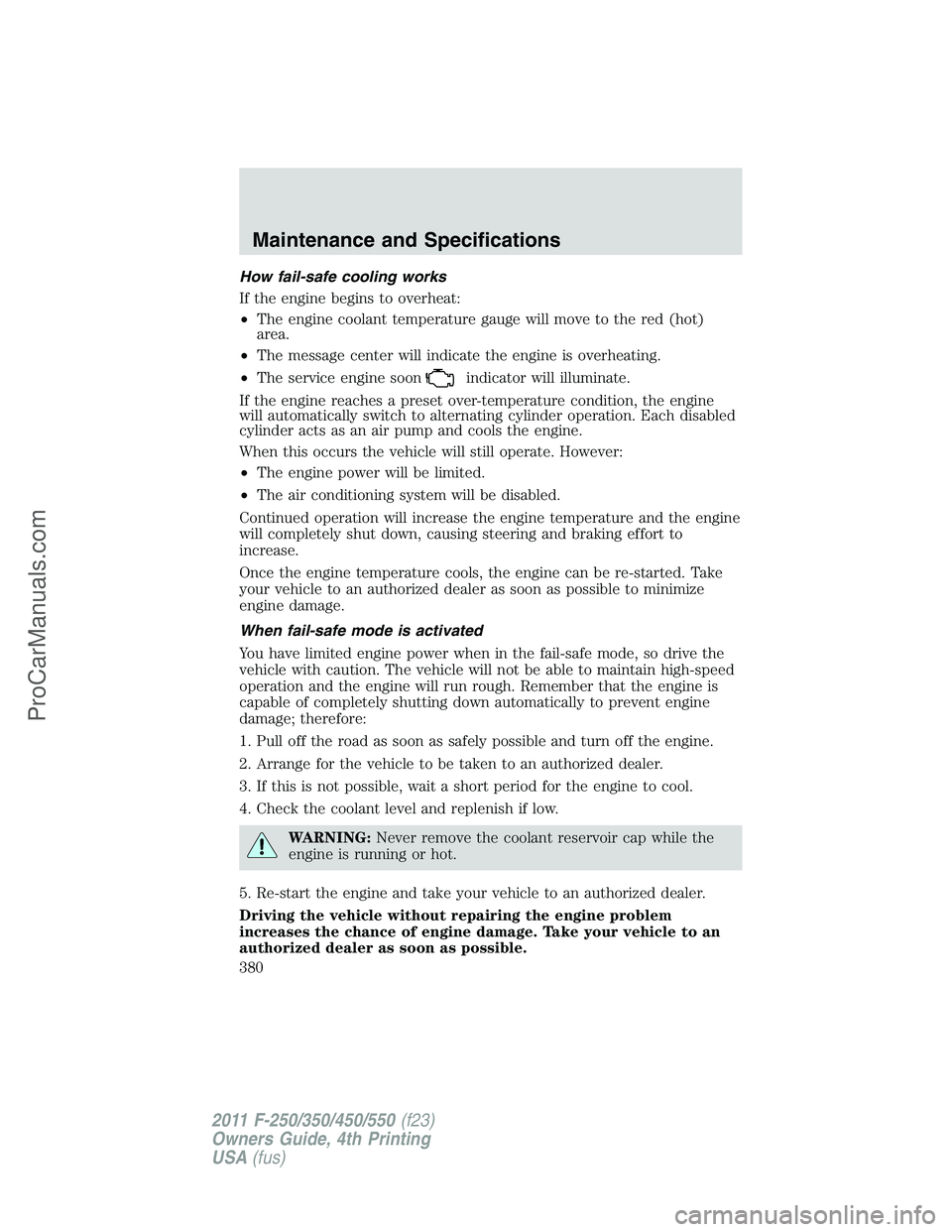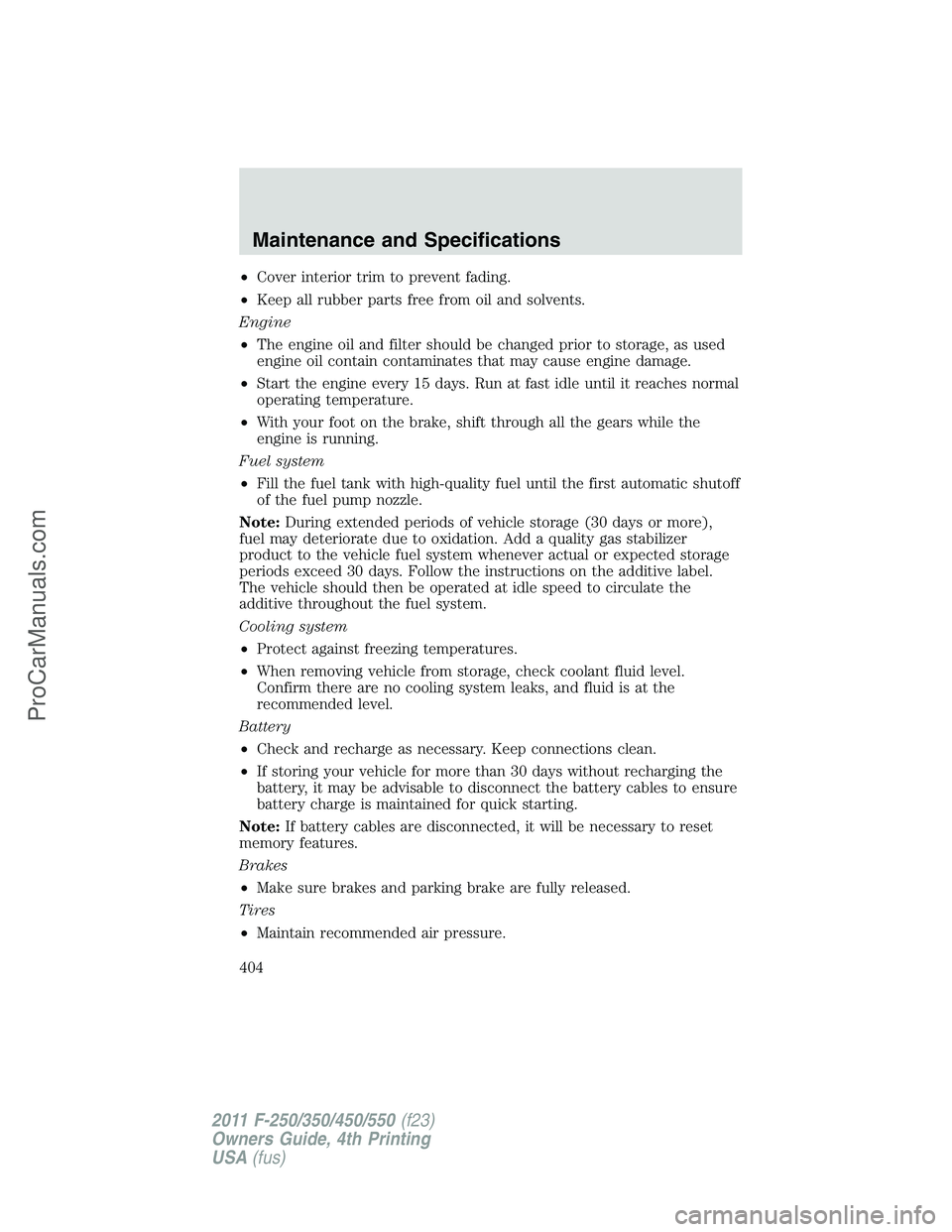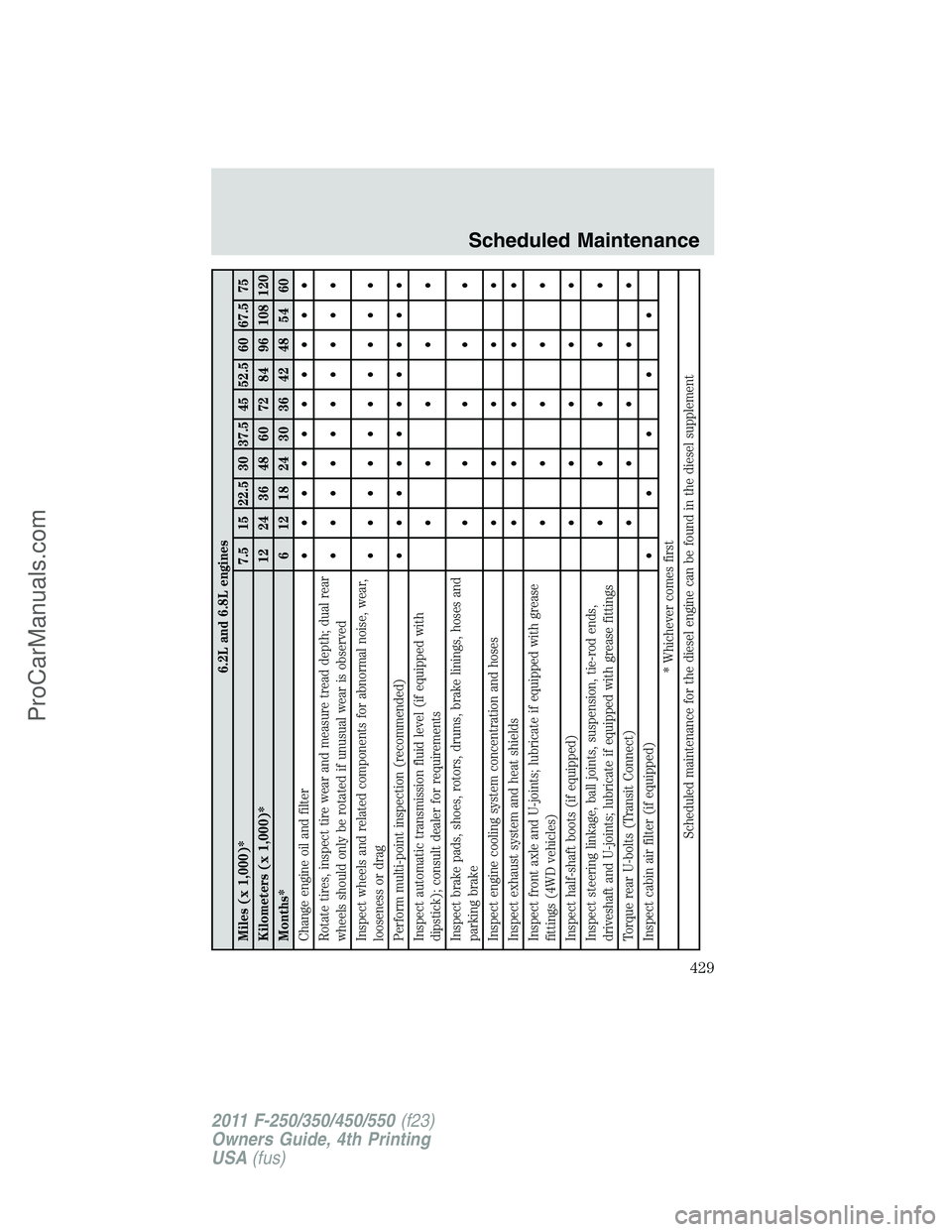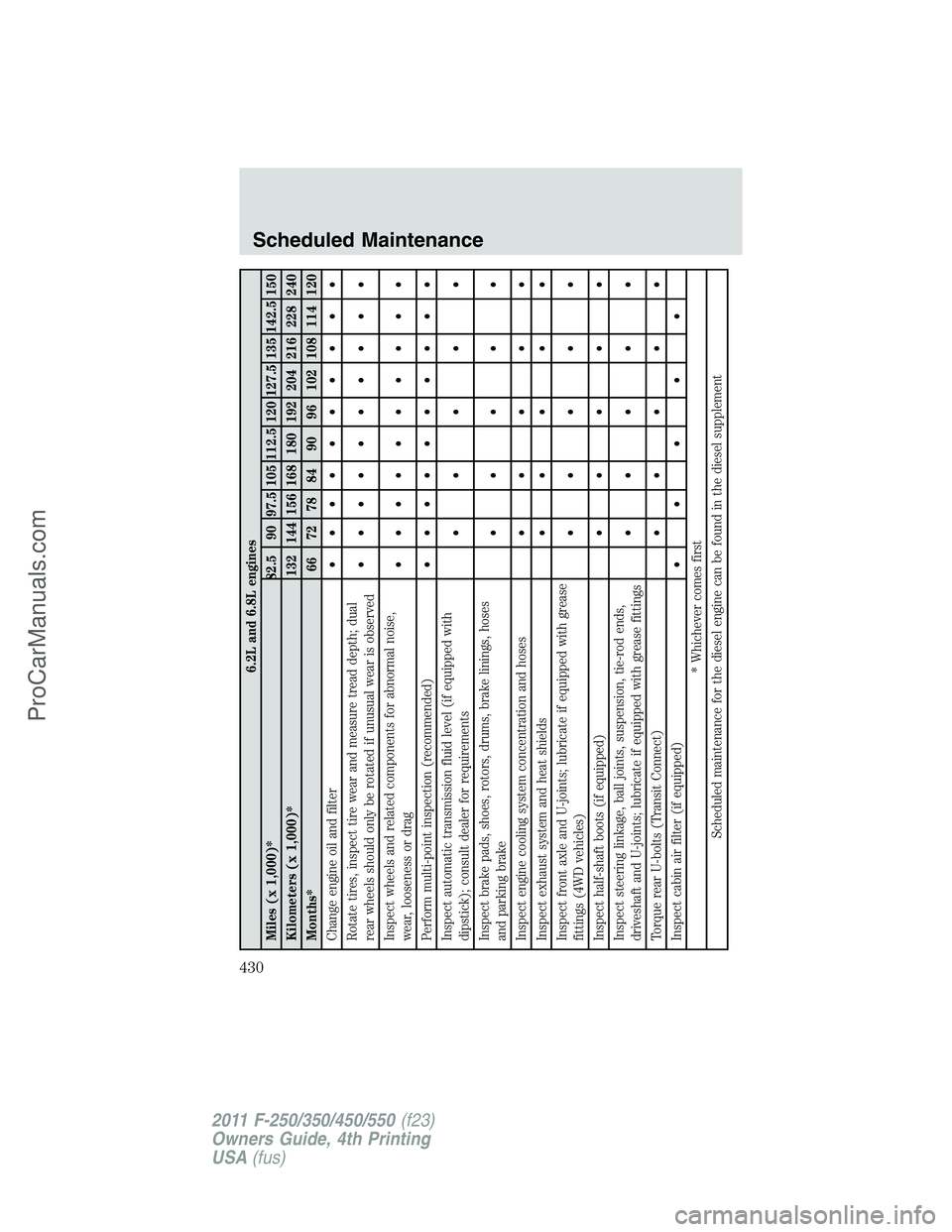2011 FORD F350 cooling
[x] Cancel search: coolingPage 380 of 449

How fail-safe cooling works
If the engine begins to overheat:
•The engine coolant temperature gauge will move to the red (hot)
area.
•The message center will indicate the engine is overheating.
•The service engine soon
indicator will illuminate.
If the engine reaches a preset over-temperature condition, the engine
will automatically switch to alternating cylinder operation. Each disabled
cylinder acts as an air pump and cools the engine.
When this occurs the vehicle will still operate. However:
•The engine power will be limited.
•The air conditioning system will be disabled.
Continued operation will increase the engine temperature and the engine
will completely shut down, causing steering and braking effort to
increase.
Once the engine temperature cools, the engine can be re-started. Take
your vehicle to an authorized dealer as soon as possible to minimize
engine damage.
When fail-safe mode is activated
You have limited engine power when in the fail-safe mode, so drive the
vehicle with caution. The vehicle will not be able to maintain high-speed
operation and the engine will run rough. Remember that the engine is
capable of completely shutting down automatically to prevent engine
damage; therefore:
1. Pull off the road as soon as safely possible and turn off the engine.
2. Arrange for the vehicle to be taken to an authorized dealer.
3. If this is not possible, wait a short period for the engine to cool.
4. Check the coolant level and replenish if low.
WARNING:Never remove the coolant reservoir cap while the
engine is running or hot.
5. Re-start the engine and take your vehicle to an authorized dealer.
Driving the vehicle without repairing the engine problem
increases the chance of engine damage. Take your vehicle to an
authorized dealer as soon as possible.
Maintenance and Specifications
380
2011 F-250/350/450/550(f23)
Owners Guide, 4th Printing
USA(fus)
ProCarManuals.com
Page 382 of 449

WARNING:Never remove the coolant reservoir cap while the
engine is running or hot.
4. If the coolant level is normal, you may restart your engine and
continue on.
5. If the coolant is low, add coolant, restart the engine and take your
vehicle to an authorized dealer. SeeAdding engine coolantin this
chapter for more information.
Refer to fail-safe cooling for additional information.
FUEL FILTER
Your vehicle is equipped with a lifetime fuel filter (gasoline vehicles only)
that is integrated with the fuel tank. Regular maintenance or
replacement is not needed. For diesel engine information, refer to the
diesel supplement.
WHAT YOU SHOULD KNOW ABOUT AUTOMOTIVE FUELS
Important safety precautions
WARNING:Do not overfill the fuel tank. The pressure in an
overfilled tank may cause leakage and lead to fuel spray and fire.
WARNING:The fuel system may be under pressure. If the fuel
filler cap is venting vapor or if you hear a hissing sound, wait
until it stops before completely removing the fuel filler cap. Otherwise,
fuel may spray out and injure you or others.
WARNING:If you do not use the proper fuel filler cap,
excessive vacuum in the fuel tank may damage the fuel system
or cause the fuel cap to disengage in a collision, which may result in
serious personal injury.
WARNING:Automotive fuels can cause serious injury or death
if misused or mishandled.
WARNING:Fuel ethanol and gasoline may contain benzene,
which is a cancer-causing agent.
Maintenance and Specifications
382
2011 F-250/350/450/550(f23)
Owners Guide, 4th Printing
USA(fus)
ProCarManuals.com
Page 404 of 449

•Cover interior trim to prevent fading.
•Keep all rubber parts free from oil and solvents.
Engine
•The engine oil and filter should be changed prior to storage, as used
engine oil contain contaminates that may cause engine damage.
•Start the engine every 15 days. Run at fast idle until it reaches normal
operating temperature.
•With your foot on the brake, shift through all the gears while the
engine is running.
Fuel system
•Fill the fuel tank with high-quality fuel until the first automatic shutoff
of the fuel pump nozzle.
Note:During extended periods of vehicle storage (30 days or more),
fuel may deteriorate due to oxidation. Add a quality gas stabilizer
product to the vehicle fuel system whenever actual or expected storage
periods exceed 30 days. Follow the instructions on the additive label.
The vehicle should then be operated at idle speed to circulate the
additive throughout the fuel system.
Cooling system
•Protect against freezing temperatures.
•When removing vehicle from storage, check coolant fluid level.
Confirm there are no cooling system leaks, and fluid is at the
recommended level.
Battery
•Check and recharge as necessary. Keep connections clean.
•If storing your vehicle for more than 30 days without recharging the
battery, it may be advisable to disconnect the battery cables to ensure
battery charge is maintained for quick starting.
Note:If battery cables are disconnected, it will be necessary to reset
memory features.
Brakes
•Make sure brakes and parking brake are fully released.
Tires
•Maintain recommended air pressure.
Maintenance and Specifications
404
2011 F-250/350/450/550(f23)
Owners Guide, 4th Printing
USA(fus)
ProCarManuals.com
Page 425 of 449

Check every month
Engine oil level
Function of all interior and exterior lights
Tires for wear and proper pressure, including spare
Windshield washer fluid level
Check every six months
Battery connections; clean if necessary
Body and door drain holes for obstructions; clean if necessary
Cooling system fluid level and coolant strength
Door weatherstrips for wear; lubricate if necessary
Hinges/latches/outside locks for proper operation; lubricate if necessary
Parking brake for proper operation
Safety belts and seat latches for wear and function
Safety warning lamps (brake, ABS, airbag, safety belt) for operation
Washer spray/wiper operation; clean or replace blades as necessary
Multi-point inspection
In order to keep your vehicle running right, it is important to have the
systems on your vehicle checked regularly. This can help identify
potential issues and prevent major problems. Ford Motor Company
recommends the following multi-point inspection be performed at every
scheduled maintenance interval to help ensure your vehicle keeps
running great.
Scheduled Maintenance
425
2011 F-250/350/450/550(f23)
Owners Guide, 4th Printing
USA(fus)
ProCarManuals.com
Page 429 of 449

6.2L and 6.8L engines
Miles (x 1,000)* 7.5 15 22.5 30 37.5 45 52.5 60 67.5 75
Kilometers (x 1,000)* 12 24 36 48 60 72 84 96 108 120
Months* 6 12 18 24 30 36 42 48 54 60
Change engine oil and filter• •••••••••
Rotate tires, inspect tire wear and measure tread depth; dual rear
wheels should only be rotated if unusual wear is observed• •••••••••
Inspect wheels and related components for abnormal noise, wear,
looseness or drag• •••••••••
Perform multi-point inspection (recommended)• •••••••••
Inspect automatic transmission fluid level (if equipped with
dipstick); consult dealer for requirements•••••
Inspect brake pads, shoes, rotors, drums, brake linings, hoses and
parking brake•••••
Inspect engine cooling system concentration and hoses•••••
Inspect exhaust system and heat shields•••••
Inspect front axle and U-joints; lubricate if equipped with grease
fittings (4WD vehicles)•••••
Inspect half-shaft boots (if equipped)•••••
Inspect steering linkage, ball joints, suspension, tie-rod ends,
driveshaft and U-joints; lubricate if equipped with grease fittings•••••
Torque rear U-bolts (Transit Connect)•••••
Inspect cabin air filter (if equipped)• ••••
* Whichever comes first
Scheduled maintenance for the diesel engine can be found in the diesel supplement
Scheduled Maintenance
429
2011 F-250/350/450/550(f23)
Owners Guide, 4th Printing
USA(fus)
ProCarManuals.com
Page 430 of 449

6.2L and 6.8L engines
Miles (x 1,000)* 82.5 90 97.5 105 112.5 120 127.5 135 142.5 150
Kilometers (x 1,000)* 132 144 156 168 180 192 204 216 228 240
Months* 66 72 78 84 90 96 102 108 114 120
Change engine oil and filter••••••••••
Rotate tires, inspect tire wear and measure tread depth; dual
rear wheels should only be rotated if unusual wear is observed••••••••••
Inspect wheels and related components for abnormal noise,
wear, looseness or drag••••••••••
Perform multi-point inspection (recommended)••••••••••
Inspect automatic transmission fluid level (if equipped with
dipstick); consult dealer for requirements•••••
Inspect brake pads, shoes, rotors, drums, brake linings, hoses
and parking brake•••••
Inspect engine cooling system concentration and hoses•••••
Inspect exhaust system and heat shields•••••
Inspect front axle and U-joints; lubricate if equipped with grease
fittings (4WD vehicles)•••••
Inspect half-shaft boots (if equipped)•••••
Inspect steering linkage, ball joints, suspension, tie-rod ends,
driveshaft and U-joints; lubricate if equipped with grease fittings•••••
Torque rear U-bolts (Transit Connect)•••••
Inspect cabin air filter (if equipped)••• • •
* Whichever comes first
Scheduled maintenance for the diesel engine can be found in the diesel supplement
Scheduled Maintenance
430
2011 F-250/350/450/550(f23)
Owners Guide, 4th Printing
USA(fus)
ProCarManuals.com
Page 444 of 449

LATCH .....................................204
recommendations ...................195
Child safety seats - booster
seats ...........................................209
Cleaning your vehicle
engine compartment ..............358
instrument panel ............361–362
interior .....................................363
plastic parts ............................360
safety belts ..............................363
washing ....................................357
waxing .....................................358
wheels ......................................358
wiper blades ............................360
Climate control (see Air
conditioning or Heating) ......77, 80
Clock ......................................60, 62
Compass, electronic
set zone adjustment .................27
Console ........................................99
overhead ..............................98–99
Controls
power seat ...............................157
steering column ......................111
Coolant
checking and adding ..............375
refill capacities ................378, 407
Cruise control (see Speed
control) ......................................109
Customer Assistance ................314
Ford accessories for your
vehicle .....................................365
Ford Extended Service
Plan ..................................418, 421
Getting assistance outside the
U.S. and Canada .....................353
Getting roadside assistance ...314
Getting the service you
need .........................................349Ordering additional owner’s
literature .................................355
Utilizing the
Mediation/Arbitration
Program ...................................353
D
Daytime running lamps (see
Lamps) .........................................88
Defrost
rear window and rearview
mirrors .......................................80
windshield .................................80
Dipstick
automatic transmission
fluid ..........................................396
engine oil .................................371
Driving under special
conditions ..................292, 304, 308
sand .........................................306
snow and ice ...........................308
through water .................307, 310
E
Electronic message center ...22, 39
Emergencies, roadside
jump-starting ..........................343
Emergency Flashers .................315
Emission control system ..........392
Engine ........................................411
cleaning ...................................358
coolant .....................................375
diesel ...........................................7
fail-safe cooling .......................379
idle speed control ...................373
refill capacities ........................407
service points ..................367–369
Engine block heater .................266
Index
444
2011 F-250/350/450/550(f23)
Owners Guide, 4th Printing
USA(fus)
ProCarManuals.com
Page 445 of 449

Engine oil ..................................371
checking and adding ..............371
dipstick ....................................371
filter, specifications ........372, 406
recommendations ...................372
refill capacities ........................407
Event data recording ....................9
Exhaust fumes ..........................265
F
Fail safe cooling ........................379
Fleet MyKey programming ......127
Flexible Fuel Vehicle (FFV) ....382
Floor mats .................................121
Fluid capacities .........................407
Fog lamps ....................................87
Four-Wheel Drive vehicles .......296
driving off road .......................303
electronic shift ................297, 301
indicator light .........................298
lever operated shift ................298
manual locking hubs ..............297
preparing to drive your
vehicle .....................................281
Fuel ............................................382
calculating fuel
economy ............................25, 389
cap ...........................................385
capacity ...................................407
choosing the right fuel ...........386
detergent in fuel .....................388
filling your vehicle with
fuel ...........................382, 385, 389
filter, specifications ........382, 406
fuel pump shut-off ..................316
improving fuel economy ........389
octane rating ...........386–387, 411
quality ......................................387running out of fuel .................388
safety information relating to
automotive fuels .....................382
Fuel - flex fuel vehicle
(FFV) .........................382, 386–387
Fuses ..................................316–317
G
Garage door opener ..................114
Gas cap (see Fuel cap) ............385
Gas mileage (see Fuel
economy) ...................................389
Gauges .........................................21
H
Hazard flashers .........................315
Headlamps ...................................86
aiming ..................................88–89
autolamp system .......................86
daytime running lights .............88
flash to pass ..............................87
high beam .................................87
replacing bulbs .........................93
turning on and off ....................86
Heating
heating and air conditioning
system .................................77, 80
Hill descent mode .....................277
Hill start assist ..........................291
Hood ..........................................367
I
Ignition ...............................262, 411
Illuminated visor mirror .............98
Index
445
2011 F-250/350/450/550(f23)
Owners Guide, 4th Printing
USA(fus)
ProCarManuals.com